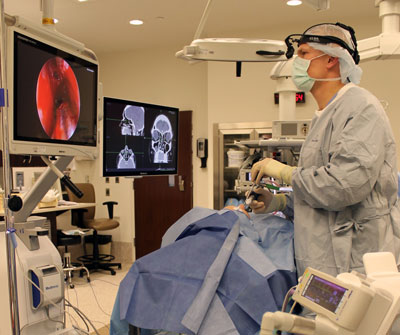Sinus Surgery
 Sinus surgery opens up pathways and clears blockages from a patient’s sinuses, cavities inside the skull which are situated at the front of the face, around the eyes and nose. It is a treatment option for people who experience chronic sinus infections, also called sinusitis, when other treatment options have failed. Head, neck and throat surgeons may also perform sinus surgery for people with abnormal sinus structure or nasal polyps.
Sinus surgery opens up pathways and clears blockages from a patient’s sinuses, cavities inside the skull which are situated at the front of the face, around the eyes and nose. It is a treatment option for people who experience chronic sinus infections, also called sinusitis, when other treatment options have failed. Head, neck and throat surgeons may also perform sinus surgery for people with abnormal sinus structure or nasal polyps.
The goal of sinus surgery is to flush out infected material, open up blocked passages and keep enough healthy tissue so a patient’s nose and sinuses can function normally. The surgery resolves most patients’ symptoms, such as nasal congestion, facial pressure and sinus headaches. In addition, most patients experience significantly fewer sinus infections.
Image-Guided Sinus Surgery
Minimally invasive image-guided sinus surgery is the standard of care for ear, nose and throat (ENT) surgical procedures. To avoid scars, sinus procedures are typically performed through a patient’s nasal cavity, a very fragile area.
Otolaryngologists who perform image-guided sinus surgery use a surgical platform and navigation system. The surgical platform creates 3D images using pre-operative CT scans of the patient’s sinus cavities. At the beginning of surgery, the surgeon scans a patient’s head to match it up with the CT scan. An electromagnetic field is then established around the patient’s head so the surgeon can guide and track instruments in real-time via the 3D images. Using a magnifying endoscope, an illuminated tubular instrument the size of a pencil with a camera at the end, the ENT surgeon removes the affected tissue and bone.
The surgical platform and navigation system increase sinus procedure accuracy and safety which results in shorter recovery, less pain and better outcomes for patients.
Watch & Learn
Ear, Nose and Throat Surgeon Dr. Jonathan Mellema explains how image-guided sinus surgery can benefit patients after other treatment options have fallen short.
Balloon Sinuplasty
Balloon sinuplasty is a minimally invasive procedure that dilates the openings of some or all three of the major nasal sinuses, enabling them to drain and clear. Otolaryngologists may perform balloon sinuplasty as part of an image-guided sinus procedure.
During balloon sinuplasty, a surgeon inserts an endoscope into the nasal passage. Once the sinus cavity is reached, the surgeon slowly inserts a small balloon catheter. Once correctly positioned, the balloon catheter is slowly inflated and pressed against the sinus walls, slightly fracturing the bone and forcing an opening.
Once the balloon is full inflated, the surgeon flushes out the passageway and cavities with a saline rinse. The balloon is then removed and the sinus is left to drain naturally.
Because no tissue or bone is cut, patients who have balloon sinuplasty typically experience a very short and quick recovery time.
System Providers:

Donald Bennett, M.D.
- Ear, Nose & Throat
- Sinus Surgery
- Midwest Ear Nose and Throat
- Brookings Hospital


